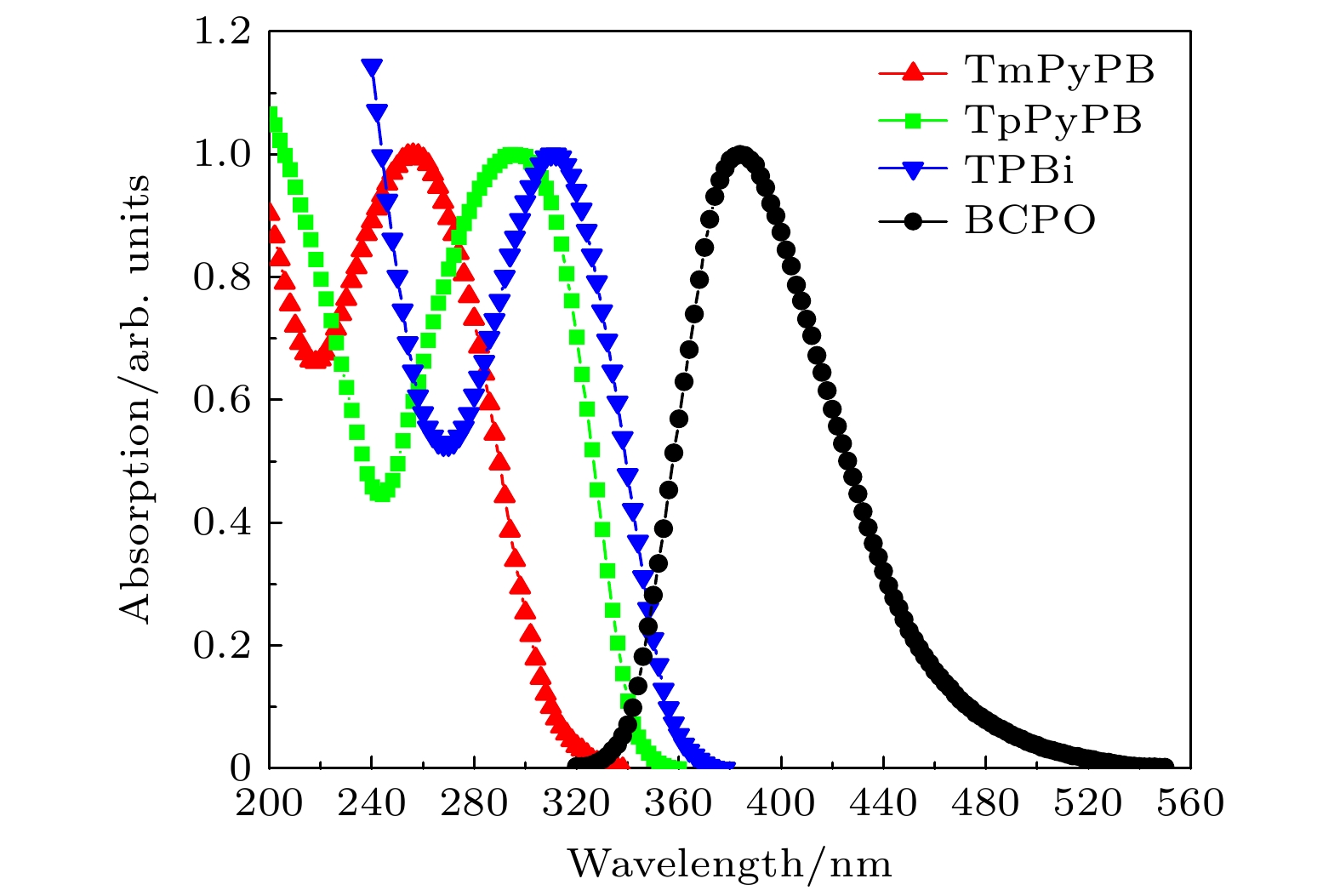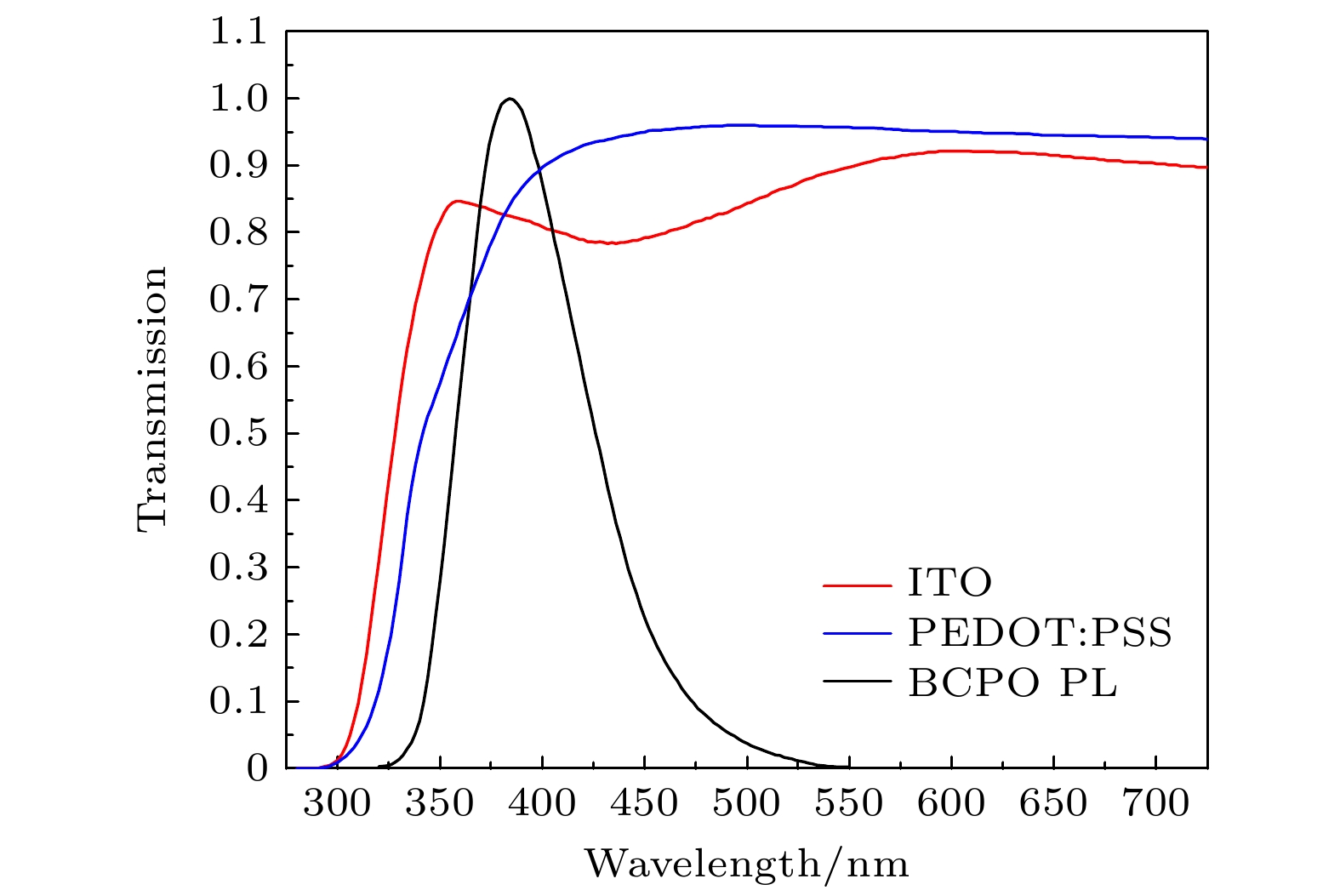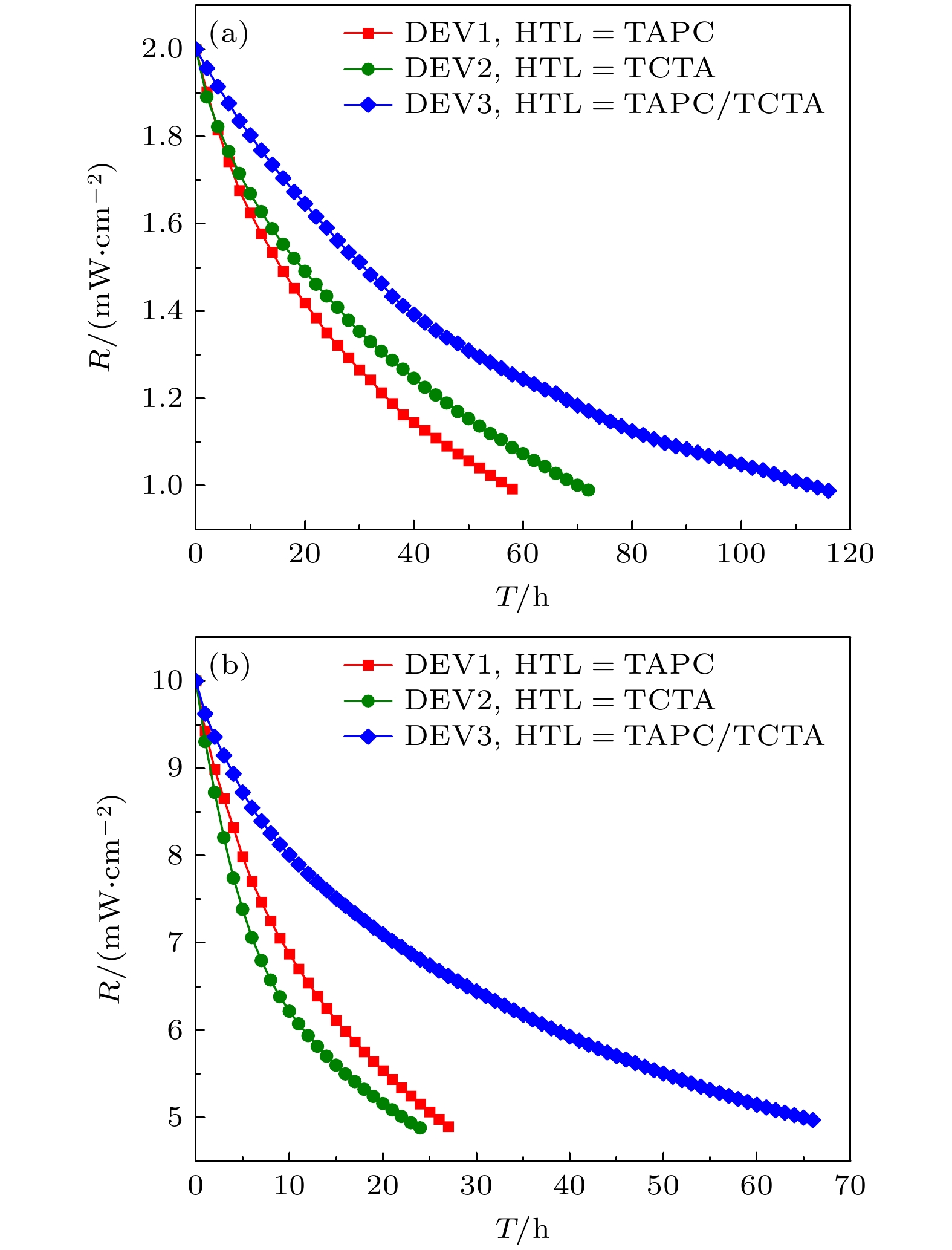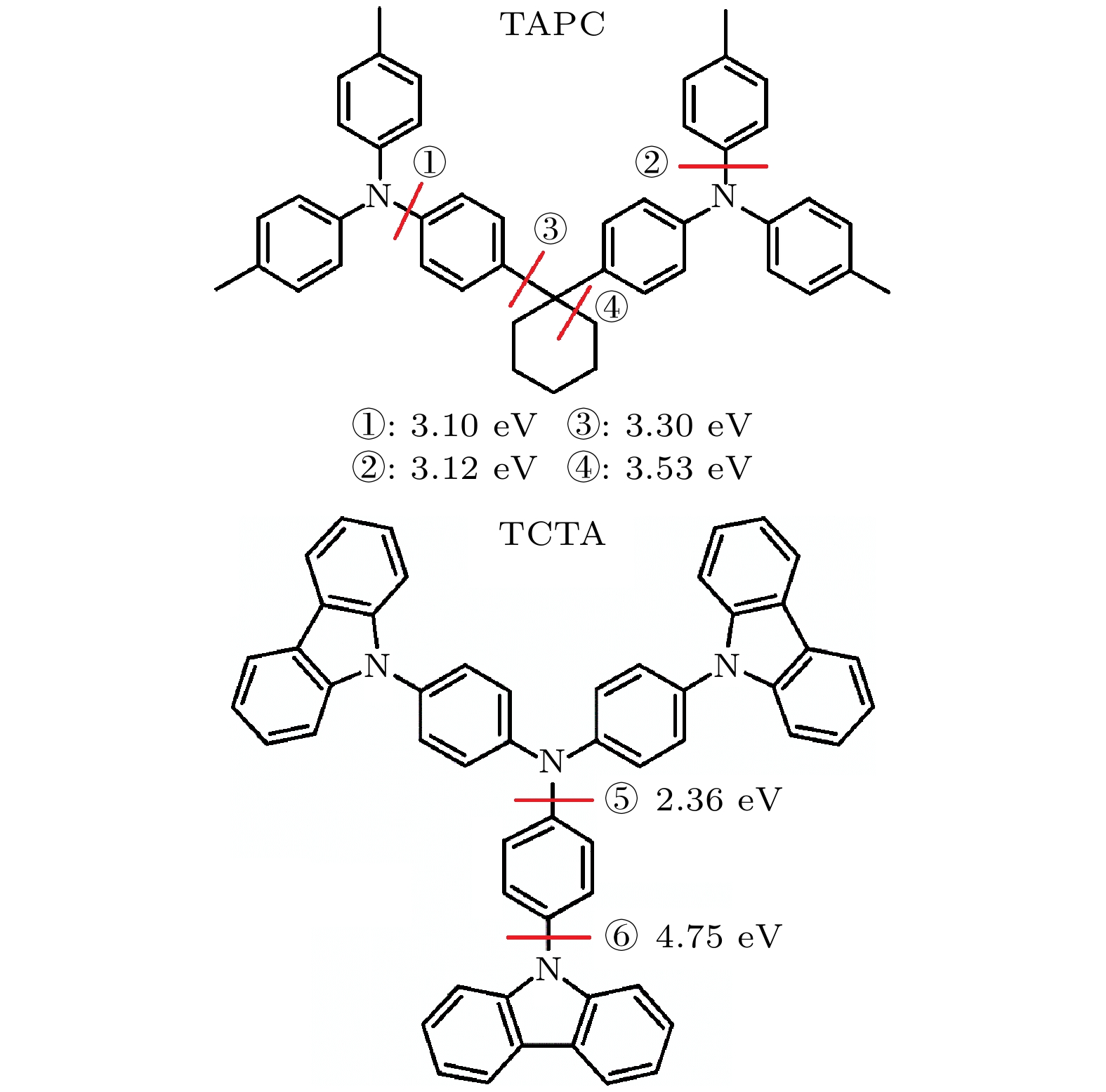-
To date, in the traditional method of obtaining near-ultraviolet (NUV) light, mercury atoms, which can create a highly toxic heavy metal contaminant, have been used. Therefore, it is an important issue to obtain NUV light by using new environmentally friendly devices. In the last decade, the fabrication of near ultraviolet organic light-emitting diodes (NUV-OLEDs) has become a research hotspot in the field of organic electronics. However, when the electroluminescence wavelength is extended to shorter than 400 nm, higher requirements are put forward for the materials used for each functional layer in these devices. In this work, a wide bandgap small molecule material of BCPO is used as the luminescent layer. The electron-transporting and hole-transporting materials are determined based on the overlaps between absorption spectra of these materials and emission spectrum of BCPO. And NUV-OLEDs with electroluminescent peak wavelength at 384 nm are prepared. By using the optimal device structure, the maximum external quantum efficiency of the device reaches 2.98%, and the maximum radiance of the device reaches 38.2 mW/cm2. In the electroluminescence spectrum, NUV light with wavelengths below 400 nm accounts for 57% of the light emission. In addition, the device demonstrates good stability when biased at two different constant voltage modes. The multiple key factors which affect the stability of the device are analyzed in detail. Firstly, it is found that the high glass transition temperature (Tg) of hole-transporting material is very important for the long-time stability of this device. The poor device stability is closely related to the low Tg temperature of hole-transporting material. Secondly, due to the widespread use of PEDOT:PSS as hole injection material in OLEDs, the electron leakage from the hole-transpor layer into the PEDOT:PSS layer may cause significant damage to the conducting polymer. When bombarded with low energy electrons, bond breakage occurs on the surface of PEDOT:PSS, followed by the release of oxygen and sulfur, resulting in changes in conductivity and oxidation reactions with molecules of hole transport material. Thirdly, the photoelectrical stability of organic molecules is the most fundamental reason that restricts the device lifetime. The aging process of material or device is directly relevant to the bond dissociation energy (BDE) of organic molecule. Generally, the BDE value of organic molecule is not high enough. As a result, molecules are prone to chemical bond breakage during electrochemical or photochemical aging. In summary, highly stable NUV-OLEDs should be fabricated by using hole-transporting materials with high Tg temperature, sufficient electron-blocking capacity, and large BDE value.
-
Keywords:
- organic light-emitting diode /
- near ultraviolet light /
- radiances /
- external quantum efficiency
[1] 连加荣, 曾鹏举 2010 现代显示 118 35
 Google Scholar
Google Scholar
Lian J R, Zeng P J 2010 Adv. Disp. 118 35
 Google Scholar
Google Scholar
[2] Chen M Y, Liao Y J, Lin Y, Xu T, Lan W X, Wei B, Yuan Y F, Li D L, Zhang X W 2020 J. Mater. Chem. C 8 14665
 Google Scholar
Google Scholar
[3] 娄敬丽, 黎刚刚, 王志明, 唐本忠 2023 发光学报 44 37
 Google Scholar
Google Scholar
Lou J L, Li G G, Wang Z M, Tang B Z 2023 Chin. J. Lumin. 44 37
 Google Scholar
Google Scholar
[4] 王瀚洋, 朱元烨, 谢凤鸣, 李艳青, 唐建新 2023 发光学报 44 140
 Google Scholar
Google Scholar
Wang H Y, Zhu Y Y, Xie F M, Li Y Q, Tang J X 2023 Chin. J. Lumin. 44 140
 Google Scholar
Google Scholar
[5] 杨文静, 孙玥, 叶丹, 王姣, 张伟, 李晓蕾, 王先良 2017 环境与健康 34 1100
 Google Scholar
Google Scholar
Yang W J, Sun Y, Ye D, Wang J, Zhang W, Li X L, Wang X L 2017 J. Environ. Health 34 1100
 Google Scholar
Google Scholar
[6] Li Z G, Jia P Q, Zhao F, Kang Y K 2018 Int. J. Environ. Res. Public Health 15 2766
 Google Scholar
Google Scholar
[7] Mikami A, Mizuno Y, Takeda S 2008 SID Symp. Dig. Tech. Pap. 39 215
 Google Scholar
Google Scholar
[8] Zhang X W, You F J, Liu S Q, Mo B J, Zhang Z L, Xiong J, Cai P, Xue X G, Zhang J, Wei B 2017 Appl. Phys. Lett. 110 043301
 Google Scholar
Google Scholar
[9] Lin J, Guo X Y, Lü Y, Liu X Y, Wang Y 2020 ACS Appl. Mater. Interfaces 12 10717
 Google Scholar
Google Scholar
[10] Luo Y J, Li S B, Zhao Y H, Li C, Pang Z G, Huang Y, Yang M H, Zhou L, Zheng X J, Pu X M, Lu Z Y 2020 Adv. Mater. 32 2001248
 Google Scholar
Google Scholar
[11] Zhang H, Li G G, Guo X M, Zhang K, Zhang B, Guo X C, Li Y X, Fan J Z, Wang Z M, Ma D G, Tang B Z 2021 Angew. Chem. 133 22415
 Google Scholar
Google Scholar
[12] Li G G, Li B X, Zhang H, Guo X C, Lin C W, Chen K Q, Wang Z M, Ma D G, Tang B Z 2022 ACS Appl. Mater. Interfaces 14 10627
 Google Scholar
Google Scholar
[13] Chen J K, Liu H, Guo J J, Wang J H, Qiu N L, Xiao S, Chi J J, Yang D Z, Ma D G, Zhao Z J, Tang B Z 2022 Angew. Chem. 61 e202116810
 Google Scholar
Google Scholar
[14] Peng L, Lü J C, Xiao S, Huo Y M, Liu Y C, Ma D G, Ying S A, Yan S K 2022 Chem. Eng. J. 450 138339
 Google Scholar
Google Scholar
[15] 马治军, 雷霆, 裴坚, 刘晨江 2013 化学进展 25 961
 Google Scholar
Google Scholar
Ma Z J, Lei T, Pei J, Liu C J 2013 Prog. Chem. 25 961
 Google Scholar
Google Scholar
[16] 王芳芳, 陶友田, 黄维 2015 化学学报 73 9
 Google Scholar
Google Scholar
Wang F F, Tao Y T, Huang W 2015 Acta Chim. Sinica 73 9
 Google Scholar
Google Scholar
[17] Chou H H, Cheng C H 2010 Adv. Mater. 22 2468
 Google Scholar
Google Scholar
[18] Yan F, Xing G C, Chen R, Demir H V, Sun H D, Sum T C, Sun X W 2015 Appl. Phys. Lett. 106 023302
 Google Scholar
Google Scholar
[19] Knauer K A, Najafabadi E, Haske W, Kippelen B 2012 Appl. Phys. Lett. 101 103304
 Google Scholar
Google Scholar
[20] Wang S M, Wang X D, Yao B, Zhang B H, Ding J Q, Xie Z Y, Wang L X 2015 Sci. Rep. 5 12487
 Google Scholar
Google Scholar
[21] Chu T Y, Song O K 2007 Appl. Phys. Lett. 90 203512
 Google Scholar
Google Scholar
[22] Gao C H, Zhou D Y, Gu W, Shi X B, Wang Z K, Liao L S 2013 Org. Electron. 14 1177
 Google Scholar
Google Scholar
[23] Kim J H, Chen Y, Liu R, So F 2014 Org. Electron. 15 2381
 Google Scholar
Google Scholar
[24] 牛泉, 郝洪敏, 林雯欣, 黄江夏 2023 发光学报 44 186
 Google Scholar
Google Scholar
Niu Q, Hao H M, Lin W X, Huang J X 2023 Chin. J. Lumin. 44 186
 Google Scholar
Google Scholar
[25] Van Der Gon A W D, Birgerson J, Fahlman M, Salaneck W R 2002 Org. Electron. 3 111
 Google Scholar
Google Scholar
[26] So F, Kondakov D 2010 Adv. Mater. 22 3762
 Google Scholar
Google Scholar
[27] Song W, Lee J Y 2017 Adv. Optical Mater. 5 1600901
 Google Scholar
Google Scholar
[28] Lee H L, Lee K H, Lee J Y 2019 Dyes and Pigments 171 107714
 Google Scholar
Google Scholar
[29] Dong S C, Xu L S, Tang C W 2017 Org. Electron. 42 379
 Google Scholar
Google Scholar
[30] Kondakov D 2008 J. Appl. Phys. 104 084520
 Google Scholar
Google Scholar
-
表 1 三种电子传输材料的性能参数对比
Table 1. Comparison of property parameters of three electron-transporting materials.
材料名称 EHOMO/ELUMO/eV Eg/eV μe/(10–3 cm2·V–1·s–1) Tg/℃ TPBi –6.2/–2.7 3.5 0.1 76 TpPyPB –6.65/–3.04 3.61 3.4—7.9 79 TmPyPB –6.7/–2.7 4.0 1.0 79 表 2 三种空穴传输材料的性能参数对比
Table 2. Comparison of property parameters of three hole-transporting materials.
材料名称 EHOMO/ELUMO/eV Eg/eV μh/(10–3 cm2·V–1·s–1) Tg/℃ NPB –5.5/–2.0 3.5 1.0 95 TCTA –5.7/–2.3 3.4 0.19 151 TAPC –5.5/–2.0 3.5 10 78 表 3 具有不同空穴传输层器件的性能对比
Table 3. Performance comparison of devices with different hole-transporting layers.
器件名称 Von/V Rmax/(mW·cm–2) EQEmax/% DEV1 3.5 38.7 2.69 DEV2 4.0 22.6 2.08 DEV3 3.5 38.2 2.98 -
[1] 连加荣, 曾鹏举 2010 现代显示 118 35
 Google Scholar
Google Scholar
Lian J R, Zeng P J 2010 Adv. Disp. 118 35
 Google Scholar
Google Scholar
[2] Chen M Y, Liao Y J, Lin Y, Xu T, Lan W X, Wei B, Yuan Y F, Li D L, Zhang X W 2020 J. Mater. Chem. C 8 14665
 Google Scholar
Google Scholar
[3] 娄敬丽, 黎刚刚, 王志明, 唐本忠 2023 发光学报 44 37
 Google Scholar
Google Scholar
Lou J L, Li G G, Wang Z M, Tang B Z 2023 Chin. J. Lumin. 44 37
 Google Scholar
Google Scholar
[4] 王瀚洋, 朱元烨, 谢凤鸣, 李艳青, 唐建新 2023 发光学报 44 140
 Google Scholar
Google Scholar
Wang H Y, Zhu Y Y, Xie F M, Li Y Q, Tang J X 2023 Chin. J. Lumin. 44 140
 Google Scholar
Google Scholar
[5] 杨文静, 孙玥, 叶丹, 王姣, 张伟, 李晓蕾, 王先良 2017 环境与健康 34 1100
 Google Scholar
Google Scholar
Yang W J, Sun Y, Ye D, Wang J, Zhang W, Li X L, Wang X L 2017 J. Environ. Health 34 1100
 Google Scholar
Google Scholar
[6] Li Z G, Jia P Q, Zhao F, Kang Y K 2018 Int. J. Environ. Res. Public Health 15 2766
 Google Scholar
Google Scholar
[7] Mikami A, Mizuno Y, Takeda S 2008 SID Symp. Dig. Tech. Pap. 39 215
 Google Scholar
Google Scholar
[8] Zhang X W, You F J, Liu S Q, Mo B J, Zhang Z L, Xiong J, Cai P, Xue X G, Zhang J, Wei B 2017 Appl. Phys. Lett. 110 043301
 Google Scholar
Google Scholar
[9] Lin J, Guo X Y, Lü Y, Liu X Y, Wang Y 2020 ACS Appl. Mater. Interfaces 12 10717
 Google Scholar
Google Scholar
[10] Luo Y J, Li S B, Zhao Y H, Li C, Pang Z G, Huang Y, Yang M H, Zhou L, Zheng X J, Pu X M, Lu Z Y 2020 Adv. Mater. 32 2001248
 Google Scholar
Google Scholar
[11] Zhang H, Li G G, Guo X M, Zhang K, Zhang B, Guo X C, Li Y X, Fan J Z, Wang Z M, Ma D G, Tang B Z 2021 Angew. Chem. 133 22415
 Google Scholar
Google Scholar
[12] Li G G, Li B X, Zhang H, Guo X C, Lin C W, Chen K Q, Wang Z M, Ma D G, Tang B Z 2022 ACS Appl. Mater. Interfaces 14 10627
 Google Scholar
Google Scholar
[13] Chen J K, Liu H, Guo J J, Wang J H, Qiu N L, Xiao S, Chi J J, Yang D Z, Ma D G, Zhao Z J, Tang B Z 2022 Angew. Chem. 61 e202116810
 Google Scholar
Google Scholar
[14] Peng L, Lü J C, Xiao S, Huo Y M, Liu Y C, Ma D G, Ying S A, Yan S K 2022 Chem. Eng. J. 450 138339
 Google Scholar
Google Scholar
[15] 马治军, 雷霆, 裴坚, 刘晨江 2013 化学进展 25 961
 Google Scholar
Google Scholar
Ma Z J, Lei T, Pei J, Liu C J 2013 Prog. Chem. 25 961
 Google Scholar
Google Scholar
[16] 王芳芳, 陶友田, 黄维 2015 化学学报 73 9
 Google Scholar
Google Scholar
Wang F F, Tao Y T, Huang W 2015 Acta Chim. Sinica 73 9
 Google Scholar
Google Scholar
[17] Chou H H, Cheng C H 2010 Adv. Mater. 22 2468
 Google Scholar
Google Scholar
[18] Yan F, Xing G C, Chen R, Demir H V, Sun H D, Sum T C, Sun X W 2015 Appl. Phys. Lett. 106 023302
 Google Scholar
Google Scholar
[19] Knauer K A, Najafabadi E, Haske W, Kippelen B 2012 Appl. Phys. Lett. 101 103304
 Google Scholar
Google Scholar
[20] Wang S M, Wang X D, Yao B, Zhang B H, Ding J Q, Xie Z Y, Wang L X 2015 Sci. Rep. 5 12487
 Google Scholar
Google Scholar
[21] Chu T Y, Song O K 2007 Appl. Phys. Lett. 90 203512
 Google Scholar
Google Scholar
[22] Gao C H, Zhou D Y, Gu W, Shi X B, Wang Z K, Liao L S 2013 Org. Electron. 14 1177
 Google Scholar
Google Scholar
[23] Kim J H, Chen Y, Liu R, So F 2014 Org. Electron. 15 2381
 Google Scholar
Google Scholar
[24] 牛泉, 郝洪敏, 林雯欣, 黄江夏 2023 发光学报 44 186
 Google Scholar
Google Scholar
Niu Q, Hao H M, Lin W X, Huang J X 2023 Chin. J. Lumin. 44 186
 Google Scholar
Google Scholar
[25] Van Der Gon A W D, Birgerson J, Fahlman M, Salaneck W R 2002 Org. Electron. 3 111
 Google Scholar
Google Scholar
[26] So F, Kondakov D 2010 Adv. Mater. 22 3762
 Google Scholar
Google Scholar
[27] Song W, Lee J Y 2017 Adv. Optical Mater. 5 1600901
 Google Scholar
Google Scholar
[28] Lee H L, Lee K H, Lee J Y 2019 Dyes and Pigments 171 107714
 Google Scholar
Google Scholar
[29] Dong S C, Xu L S, Tang C W 2017 Org. Electron. 42 379
 Google Scholar
Google Scholar
[30] Kondakov D 2008 J. Appl. Phys. 104 084520
 Google Scholar
Google Scholar
-
 4-20231301Suppl.pdf
4-20231301Suppl.pdf

Catalog
Metrics
- Abstract views: 5162
- PDF Downloads: 59
- Cited By: 0

















 DownLoad:
DownLoad:





